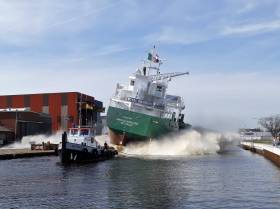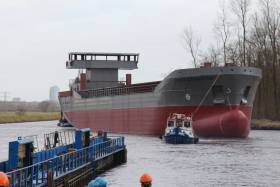Displaying items by tag: Newbuild
Vanguard's Lunchtime Launch for Arklow's Dutch Operations
#LunchLaunch - The final day of March marked the launch of yet another newbuild as part of an ongoing modernisation programme of the Arklow Shipping fleet, writes Jehan Ashmore.
Arklow Vanguard (yard no. 726) was given a lunchtime launch under glorious conditions. Turning out to see the spectacle were locals that were invited by the Dutch yard in Hoogezand. The 5,150dwat Bodewes Trader was given the customary sideways launch followed by wave splash that just added to the occasion.
The shipyard, Royal Bodewes has so far completed five of the ships under the ‘V’ naming series that began with launch of leadship Arklow Vale in 2015 (see video). With the launch of Arklow Vanguard, this marks the second half-way point as a total of 10 such cargoships are on order. They are to serve Arklow Shipping Nederland B.V. based in Rotterdam.
Among the bulk-dry cargoes that the near 87m long Arklow Vanguard is to transport will be grain, animal feed and steel rails.
Royal Bodewes has a long history in building sea-going vessels that began in 1912. The yard started constructing traditional shallow draught sailing barges, in Dutch known as "tjalks."
Almost a decade later saw the first motorized cargoships introduced. They offered 'for the time' a modern approach for both ocean going and inland water vessels. In addition these motorships with an optimized cargo hold met the wishes of the shipowners.
New Navigator to Trade Timber On Short-Sea Services
#Newbuild - Scot Line a trader of packaged timber on the Irish Sea have added a 88 metre long newbuild to its fleet that operates an Ireland-UK-Scandinavia liner service, writes Jehan Ashmore.
The newbuild Scot Navigator will become the 10th vessel of the fleet in which such ships are regulars to Irish east coast ports, Dublin and 35 miles to the south Wicklow. The port became the first of five Regional Ports of Significance having been transferred to local authority control under the 2013 National Ports Policy.
Imports of packaged timber are for the construction industry, a 'bread and butter' cargo trade for Wicklow Port. A role potentially involving Scot Navigator which was launched last month in the Dutch yard of GS Yard B.V. in Groningen. Delivery and operational service is scheduled for May.
The modern efficient design of Scot Navigator makes for an ideal addition to the operators expanding fleet, being built with a timber-fitted capacity of about 5,500 cubic metres. The newbuild also complies with all the latest legislation including provisions for ballast water treatment.
Scot Navigator will be powered by a Caterpillar engine. The new ship is to sail under the UK flag like the rest of the fleet among them Scot Leader which was acquired in recent months. This cargoship is also of similar length but with a larger timber-fitted capacity of 6,325 cubic metres.






























































